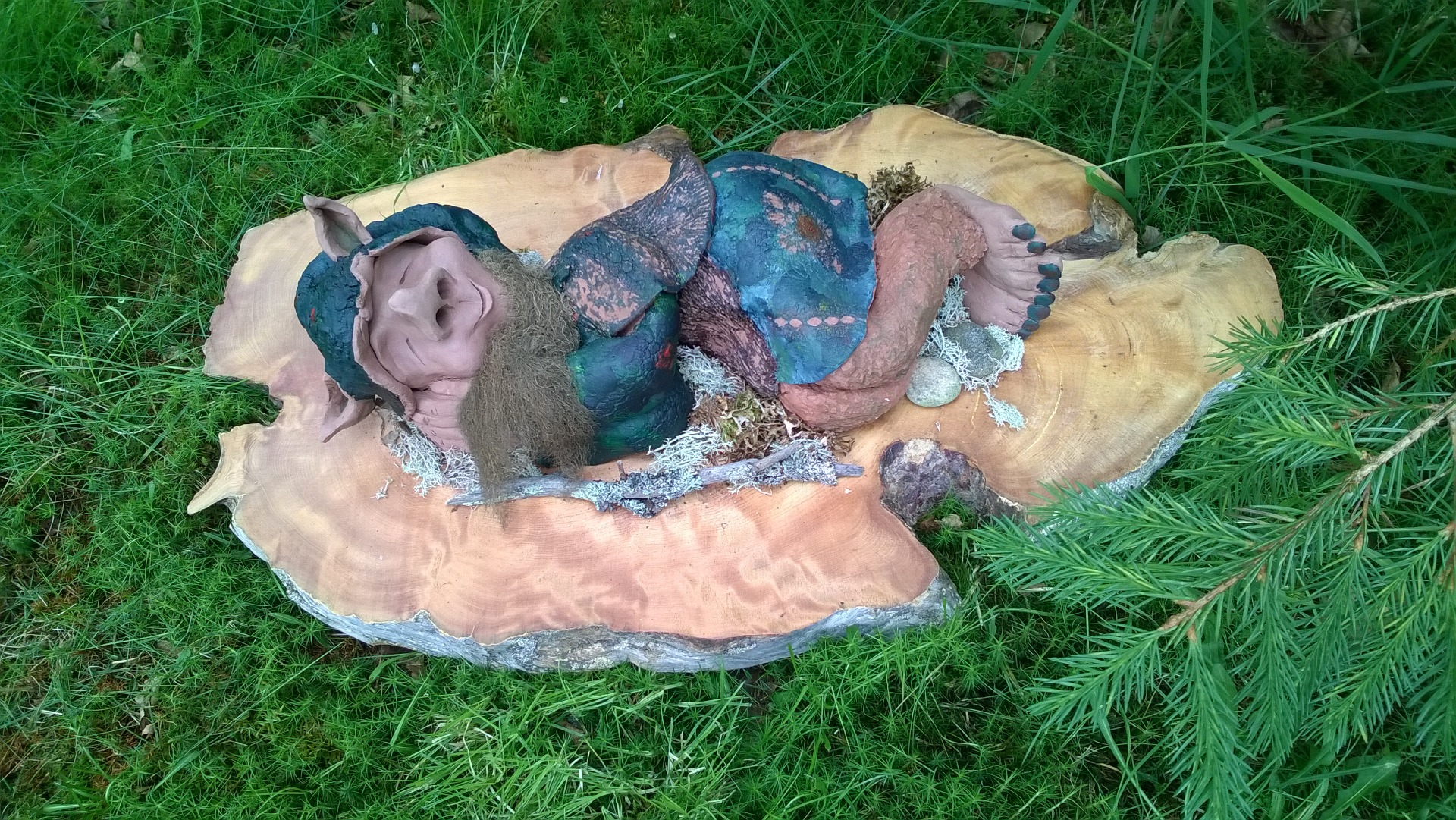Arthandicrafts with stories

Forest elves
Materials: red clay and other natural materials.
Finns have believed in elves for generations. These diminutive long-living creatures are our friendly neighbours.
Elves love the forest, and they are responsible for all animals. Elves own the forest.
In the pictue from the left: Hyvätty, Kultimo, Uljas, H.Moilanen (sold).

The Sun elk
Materials. elk antler, reindeer raw leather, reindeer antler and crystal.
According to ancient lore, the elk is related to the creation of fire, the cycle of the sun and light in the winter sky. My grandfather taught me that the Big Dipper depicts elk hunting. The tree stars of the handle are hunters, while the four stars of the ladle are elks in the spring. The sun elk bites a tree growing on a tall ridge, cutting it into two, and releasing the sun.

Fire fox
Materials: Acrylic on canvas (50x60cm).
Northern lights are explained in many ways. The Fire Fox runs somewhere in the North and its glittering fur reflects the lights of the Northern Lights. When a fire fox running in the fells whips his tail to snow so that sparks are thrown into the sky. The sparks color the sky with flickering lines, green, yellow, red, purple. This is how the entire sky is waving.

The world is small like a raisin
Materials: raisin, satellite dish, acrylic paint, wood, animal hair.
Swedish historian, Olaus Magnus, inspired the European intelligentsia to travel to the mythical North with his book History of the Northern peoples, which was published in 1555. They were intrigued by the exotic nature and peculiar seasons of Lapland.

Huttu-Ukko
Materials: acrylic on canvas (50x60cm).
Huttu-Ukko is a pleasant goblin of the mountain Pyhä. He watches the scenery from top of the mounatin, the wilderness from which his ancestors have haevsted through out the decades. He used to live in the wilderness of the lake Huttu. The first radio mast was built to mountain Pyhä in the 1950`s. There was many problems with the mast at first. It was swaying and the lamprophony was bad. So they decided to ask Huttu-Ukko for a permision to set up the mast. Huttu-Ukko was granted with a personal TV that was thrown in to the lake Huttu so that he would know why the mast was set u. Since then, there hasn`t been any problem with the mast.

Return of the salmon
Materials: reindeer leather, salmon, burbot,pike leather, cotton, birch park.
The 500-kilometre-long Kemijoki river was once among the most abundant salmon rivers in Europe. Salmon fishing, along with the cattle and farming, played a significant role in the lives of my grandfather and his grandparents. These livelihoods complemented each other. Kemijoki river provided large families vital extra earnings.

Lake of the Bear`s thirst
Materials: acrylic paint on canvas (50x60 cm).
The way bear is treated and respected in lapland is very different from any other animal. The bear has been worshipped as a God and seen as forefather of things. The bear was born in the stars and it settled on top of a pine tree wearing gold and silver. Bear has two counterparts in the northern stellar system Ursa Major and Ursa Minor, which are some of the best known constellations. Some believe that the bear was born from wool drifting in water. The wind brought wool to the North and so the bear was born.

Reindeer
Materials: acrylic on canvas (50x60 cm).
In old lappish tales, reindeer was the herd of the sun. The sun god had given them humans as a gift, so that they could survive the hard northern life. In one tale, the world was created from a reindeer fawn; its bones became the bedrock, its flesh became the soil, and its heart was hidden by the creator inside the earth. The beating of the heart can still be heard on the fells.

Noitatunturi
Materials: acrylic on canvas (50x60 cm).
The ancient Sámi believed that everything had a spirit: people, animals, plants, rocks, hills, islands, the earth, the sea, the air and even space. Their ancient mythology was a form of nature worship in which the world comprised three levels. The Sámi shaman drum represented life and the universe in the present, past and future. Noitatunturi Fell (540 m) is the highest summit in the National Park.

The Lake Squirrel
Materials: acrylic on canvas (50x60 cm).
Squirrel fur was used as a money in the aerly days of Finland. The word "money" originally meant fur of an animal, especially of a squirrel. In the prehistoric times fur of an animal was the main means of trade in Finland and in Northern Europe. Good you gouldn`t get from Lapland were traded for squirrel furs with merchants travelling to Lapland. This squirrel can run freely by the Lake Squirrel without having to be afraid of losing her fur.

Tarn of the Sacred Baptism
Because of Pyhätunturis rough and rocky ruggedness, the Sámi considered Pyhätunturi sacred. Entire animals or their parts were sacrificed at Pyhätunturi so secure success in hunting. Even in the late 17th century, Sámi were still baptised into Christianity at the Tarn and Fall of the Sacred Baptism.

